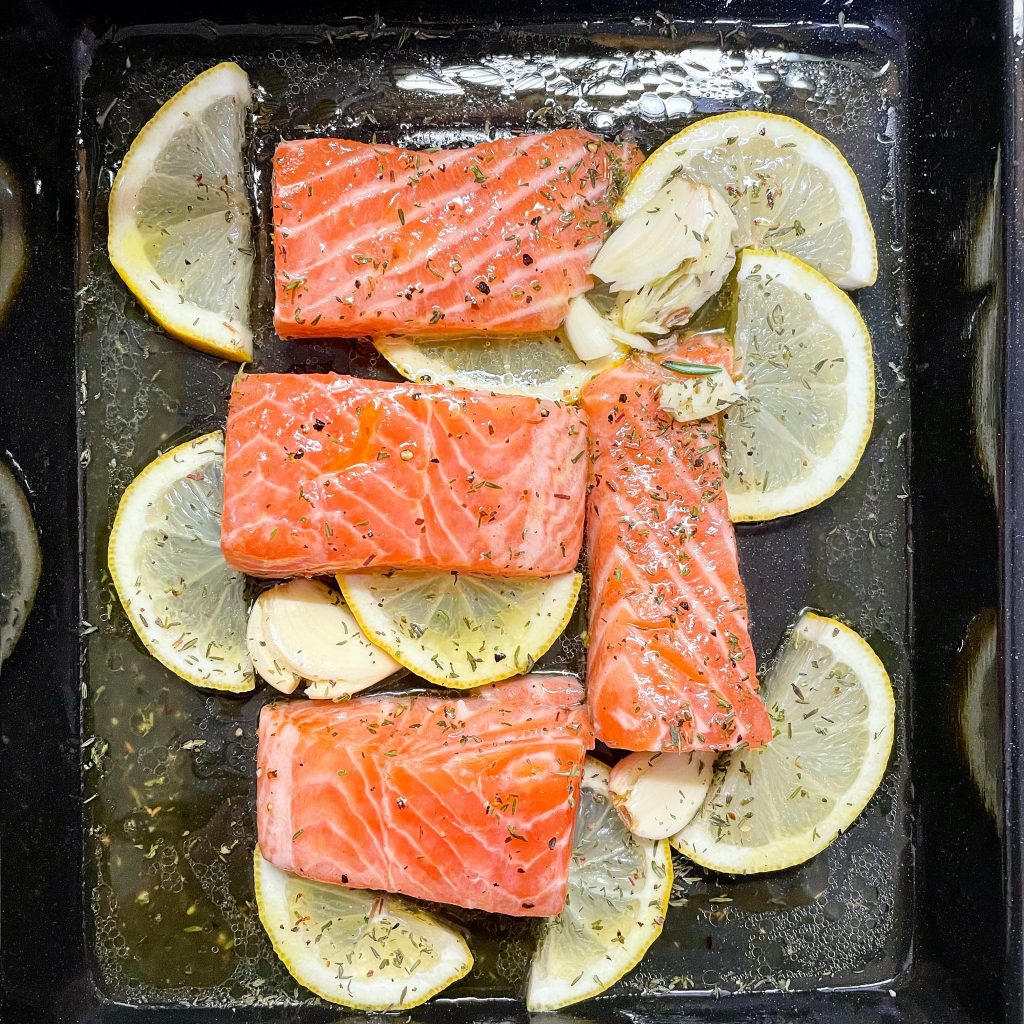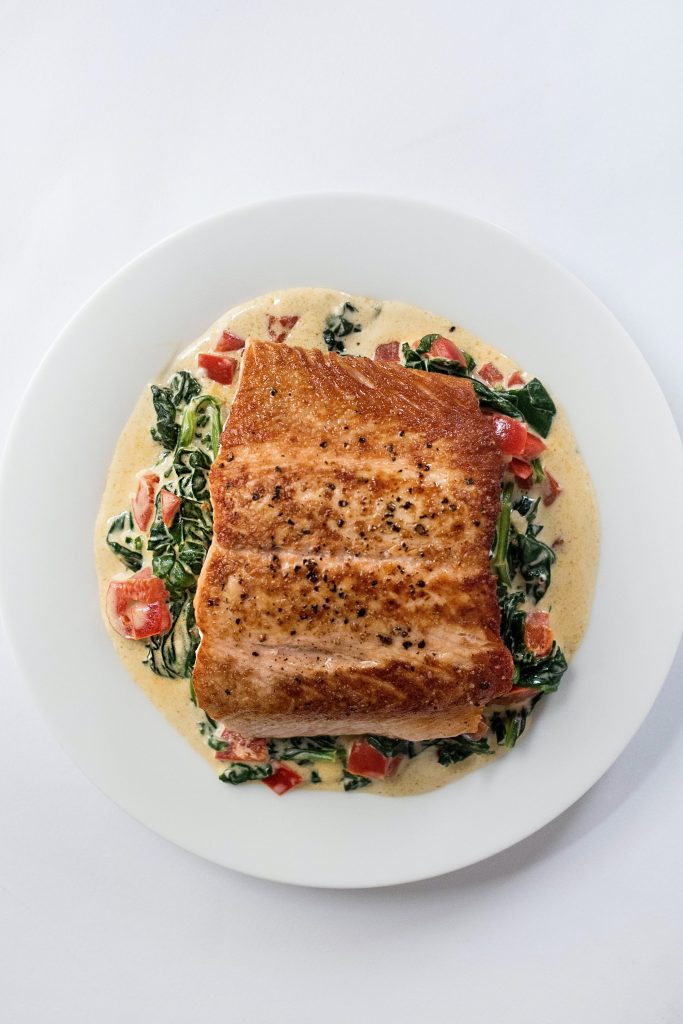As an Amazon Associate we earn from qualifying purchases.
Salmon is quite popular seafood across the globe, rich in omega-3 fatty acids. However, it tastes incredibly fishy if it is not flash frozen right after being caught. Along with buying good quality frozen Salmon, you also need to know how to cook salmon so it doesn’t taste fishy.
Quick Navigation
How to Cook Salmon So It Doesn’t Taste Fishy
Salmon is a fatty fish that decreases the risk of diabetes, heart disease, and obesity. However, incorrectly cooking it leads to a horrible smell that is hard to let go of and destroys your appetite along with the nutrients. Don’t worry, you can use my multi-method guide on how to cook Salmon, so it doesn’t taste fishy.
Method 1: Pan Fry After Milk Soak
Pan-frying is easy and can be done quickly. But you must be careful with the soaking process as underdoing or overdoing it will destroy the fish altogether. Therefore, you need to follow specific steps to do the process effectively.

Step 1: Milk Bath for Removing Fishy Taste
- Take a bowl full of milk. (Enough for the fillets to soak in)
- Soak the salmon fillets in that bowl.
- Wait for 20 minutes. (The protein in milk removes the fish odor by binding with it)
- Remove the fillets, and now you are ready to cook them.
Step 2: Prepare the Salmon Fillets for Getting Cooked
- Season the salmon fillets with salt & pepper
- Add little olive oil or butter onto the fillets.
- Place the fillets over a hot skillet.
- Keep the stove flame on medium-high.
Step 3: Pan-Fry the Salmon
- The skin side should be up on the hot skillet.
- Spread little oil or butter over it.
- Let it sizzle for around 5 to 6 minutes.
- Use a spatula to turn around the Salmon.
- Let the skin-side down cook for around 3 minutes.
- Please wait until it changes the color to golden.
- Serve it and enjoy your Salmon.
This video here will clear your doubts about how to reduce the fishy smell from store-bought Salmon.
Tip!
If you are getting a good deal on flash-frozen Salmon, then buy in a bulk quantity. Store the Salmon in your refrigerator, as it will stay fresh for a long time and can be quickly cooked.
Method 2: Oven Cooking the Salmon
Oven roasting is an excellent way to cook your Salmon in isolation and eliminate the fishiness. It is because you can easily roast more than one fillet of Salmon at a time. Hence, this takes less time for you to cook for a group.
Moreover, oven roasting is also a better alternative because it demands little or no oil, giving you all that Omega without the oil’s cholesterol.
Step 1: Prepare the Salmon Fillets for Oven Roasting
- Pull out the salmon fillets and place them over a utensil.
- Season salmon fillets with salt & pepper
- Use a baking dish and lightly grease it. (You can use a baking sheet as well)
- Place the fillets with the skin-side down.
- Preheat the oven to 400 Degrees Fahrenheit.

Step 2: Put the Salmon Fillets Into the Oven
- Put the baking sheet with fillets into the oven.
- Leave it for 12 to 15 minutes.
- You do not need to flip the salmon fillets.
- Check if the Salmon is opaque on the outside.
- Take it out of the oven, and check if you are getting any fishy odor.
Step 3: Serve the Salmon Fillets
- Serve the fillets on a plate.
- Squeeze fresh lemon over them.
- It will add freshness to the fillets’ flavor, and any remaining hints of the fishy smell will go away.
Method 3: Cooking Salmon by Poaching
While you cook Salmon or any seafood in water, the flesh of the fish becomes tender and soft. Therefore, its smell is eradicated during this fish bath. Here are the steps for you to approach this method:
- Fill a large skillet with water.
- Season the cooking liquid with any spices or herbs.
- Turn on the stove and keep it on a simmering heat.
- Put the salmon fillets in the skillet with water.
- You need to maintain low heat.
- Wait until the salmon fillets turn flaky and are cooked.
- Take the fillets out, and they are ready to serve.
Salmon and Your Health
A survey from the National Fisheries Institute found that Americans ate an average of 2.83 pounds of salmon in 2019. This is up from 2.02 pounds in 2009. The same study shows salmon is the second most popular seafood choice in restaurants.
Salmon is a source of omega-3 fatty acids DHA and EPA and, thus a fatty fish. A 100-gram of farmed Salmon consists of 2.3 grams of omega-3. Apart from that, a 100-gram of wild Salmon consists of 2.6 grams of omega-3.
This fish also has essential amino acids and contains many other beneficial compounds. These compounds include astaxanthin, selenium, and vitamin D.
Regular eating of salmon can provide many health benefits. Benefits include:
- Improved brain and eye health
- improved immunity
- lower risk of certain cancers, and
- reduced risk of developing certain autoimmune diseases.
Salmon Is Best When It Is Fresh
No matter how many health benefits cooked salmon offers, many people can’t get past its fishy taste. To enjoy the most flavorful product, buy the freshest fish possible.
According to the University of Minnesota Extension, up to 90% of fishiness in fish is due to poor handling. Fresh salmon has a milder, more enjoyable taste enjoyed without any added seasoning.
When selecting fresh fish, look for bright and shiny scales, bright eyes, and a clean and moist surface. Check for bruises or discoloration on the flesh, which may show that the fish is not fresh.
It is also important to note the smell of the fish. A fishy or ammonia-like odor indicates that the fish is not fresh.
Once you have selected a fresh piece of fish, it is important to freeze and store it well. To do so, wrap the salmon in an airtight container or tightly sealed freezer wrap and place it in the coldest part of the freezer. If it is well stored, it can last up to three months.
Effective Ways to Make Salmon Less Fishy
Marinating the fish in a combination of herbs, spices, and citrus juice can help to remove fishy taste. The herbs and spices will add an extra layer of savor. These spices will cut the fishy odor and create a more pleasant taste.
To remove fishy taste further, add a sweet honey glaze or brown sugar to the fish before cooking. This sweetness balances out the fishy flavor. The glaze’s caramelization adds a nice crunch for even the most finicky salmon hater.
Experts at Ehow suggest that another great way to remove fishy taste of your fish is to soak it in milk before cooking. The lactic acid present helps break down the proteins that cause the fishy flavor. Lactic acid also adds a mild sweetness to the fish. The same concept also works well to tenderize chicken.
As a final step, add fresh lemon juice to reduce the fishy odor. Lemon does this by adding acidity to the fish and brightening its flavor.

Frequently Asked Questions
Is Salmon Fish Rich in Nutrients?
Yes, Salmon is considered one of the most significant sources of omega-3 fatty acids DHA and EPA. A 100 gram of farmed Salmon consists of 2.3 grams of omega-3 fatty acids.
Apart from that, a 100-gram portion of wild Salmon consists of 2.6 grams of omega-3 fatty acids. For more knowledge regarding the nutritional aspects of Salmon, check out this article.
Is There Any Precaution or Limitation of Eating Salmon?
As per EPA and FDA, children should eat only 1 to 2 servings in a week. In addition, no children below the age of 2 should eat Salmon or other seafood.
It is because high omega-3 fatty acid absorption by children’s bodies is not favorable for good health.
Adults should also eat only two portions or only 8 ounces of Salmon in a week. To know more about the risk factors of eating Salmon, click on this link.
How Many Types of Salmon Fishes Are There?
There are six types: King Salmon, Coho Salmon, Pink Salmon, Sockeye Salmon, Salmo Salar, and Keta Salmon. The link here gives more details about them.
Conclusion
Fishy taste or odor can ruin the fun of eating Salmon or any of your favorite fish. Therefore, follow any of the above two methods of cooking salmon, and get the fishy taste wholly removed. To add, it is also possible to learn how to make any fish taste good by learning some techniques, such as dredging the fish.
Salmon has impeccable health benefits and is good for the heart. So, why stop consuming them only because of the fishy taste? Anyways, if you rejected fish before, now is the time to start liking fish. Cook it correctly and enjoy eating Salmon.

